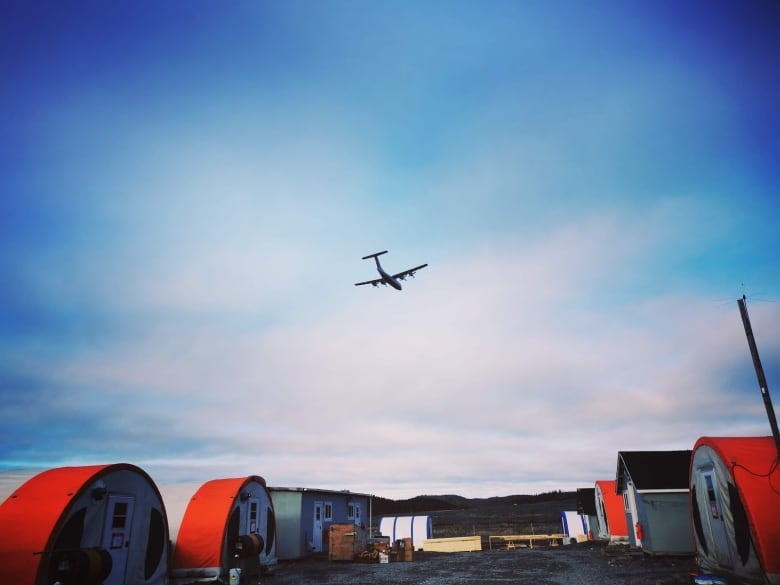N.W.T. gold mining project encouraged by Tłı̨chǫ Highway opening

When the Tłı̨chǫ Highway officially opened on Nov. 30, Fortune Minerals wasn’t the only mining company applauding the new road.
Nighthawk Gold is currently advancing its Colomac Gold project, roughly 120 kilometres northeast of Whatì.
The new all-season highway, also called N.W.T. Highway 9, goes about halfway to Colomac. From a turnoff near the community of Whatì, a winter road goes the rest of the way. The seasonal road passes through Nighthawk’s 930-square-kilometre exploration property, before ending in Wekweètì.
The highway should lengthen the season of the winter roads to Gamètì and Wekweètì, as well as Nighthawk’s project. That’s because crews don’t have to build the southern stretch of winter road anymore, as it was made redundant by the all-season highway.
‘A smart investment’
Keyvan Salehi, Nighthawk Gold’s CEO, called the 97-kilometre Tłı̨chǫ Highway “a smart investment” by governments. The territorial government funded 75 per cent of the $185-million, two-lane gravel highway, with the federal government paying for the rest.
“For us, I mean, it’s a great start,” he said. “There’s still about 100 or 120 kilometers left to extend that highway into the two communities that are north of Whatì, and our property is kind of situated in between them. So there’s still a long way to go in terms of additional expansion, but it’s definitely a start for our company and our project.
“We’re a lot closer to the all-season highway.”
The new road means Nighthawk has a longer window in the winter to truck fuel, supplies and equipment to the site. As activity at the Colomac project ramps up, the added ice road time only becomes more important.
Based on 10-year averages provided by the N.W.T. government, the Wekweètì winter road is only open for 40 days each year.
At the moment, Salehi said Nighthawk continues to focus on exploring its property by drilling down into established mineral deposits to better understand how much gold ore they contain, while also drilling into new prospective areas believed to host gold deposits.
The aim, he said, is to increase the property’s gold resource, which currently sits at nearly three million ounces of indicated and inferred resources. These mineral resource estimates provide industry investors with a guide to how much gold is believed to be in the ground. The more the company can grow that number, the better chance the company has to raise the money required to build the mine or to have a larger mining company acquire their project.
Salehi said Nighthawk’s next milestone is to release a preliminary economic assessment. This document is essentially a mine plan that provides an early idea of how the operation will run, how much it will cost to build and operate, and how many workers it will employ.
“It’s now down to us at Nighthawk to show the economic viability of our project and what this can actually deliver in terms of economics, production output, revenues, jobs and ultimately taxes and royalties to the N.W.T.,” he said.
The company hopes to release that plan by late 2022 or early 2023. At that point, it will begin the permitting process with territorial regulators, and start discussing future contracting possibilities and impact benefits agreements with the Tłı̨chǫ Government.
Mark Brajer, CEO of the Tłı̨chǫ Investment Corporation, said the relationship between Nighthawk Gold and the Tłı̨chǫ Government’s business arm has been positive to date.
“We’ve done a little bit of ad hoc work with them, but it’s getting a little more serious, the discussions now,” he said, as the future of the operation comes into focus.
A Tłı̨chǫ Highway extension?
Salehi said all-season roads and connections to power grids make it easier for mining companies to raise money on capital markets, which allows them to develop and build mines.
Still, he said he realized it’s a hard sell to ask governments to build tax-payer funded infrastructure exclusively for mining projects. “This 97-kilometre highway has been built. It was not done for us. It wasn’t done for Fortune Minerals. And that’s the way it should be,” he said.
“Ultimately, it’s got to be able to serve communities in the long run. Projects like mining companies come and go, right?”
Wekweètì Chief Adeline Judas Football said the all-season highway is not a priority at the moment, but it’s an item she will be discussing with Gamètì Chief Doreen Arrowmaker early next year. Both women were elected in June 2021.
“Right now, because we are new to the chief [positions] and we were just recently elected, it’s something that we are looking forward to discussing, but not right now.”
Colomac’s long history
Nighthawk has centred much of its exploration on its Colomac Gold Project. The company has been exploring the area since acquiring mineral claims and leases in late 2011. (The company changed names from Merc International to Nighthawk Gold in 2012.)
Between 1990 and 1997, 527,000 ounces of gold were produced at Colomac, until then-owner Royal Oak Mines went into receivership.
In the decade-plus that followed, the federal government paid $149 million to clean up the property.
The original news story can be found on the CBC news website



